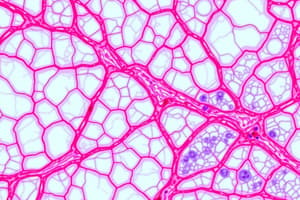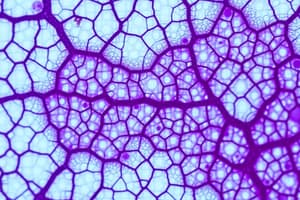Podcast
Questions and Answers
What type of connective tissue is characterized by high tensile strength and is commonly found in tendons and bones?
What type of connective tissue is characterized by high tensile strength and is commonly found in tendons and bones?
- Loose connective tissue
- Dense regular connective tissue (correct)
- Reticular connective tissue
- Elastic connective tissue
Which cells in connective tissue derive from B lymphocytes and play a crucial role in the immune response?
Which cells in connective tissue derive from B lymphocytes and play a crucial role in the immune response?
- Fibroblasts
- Macrophages
- Plasma cells (correct)
- Mast cells
Which type of ground substance is found in connective tissue and consists of a core protein with attached glycosaminoglycans?
Which type of ground substance is found in connective tissue and consists of a core protein with attached glycosaminoglycans?
- Fibers
- Collagen
- Glycoproteins
- Proteoglycans (correct)
What is the primary function of the extracellular matrix (ECM) in connective tissue?
What is the primary function of the extracellular matrix (ECM) in connective tissue?
Which of the following cells are classified as wandering cells in connective tissue?
Which of the following cells are classified as wandering cells in connective tissue?
What type of collagen fibers predominantly characterize dense regular connective tissue?
What type of collagen fibers predominantly characterize dense regular connective tissue?
Mesoderm is responsible for giving rise to which component of connective tissue?
Mesoderm is responsible for giving rise to which component of connective tissue?
Which of the following is NOT a characteristic of loose (areolar) connective tissue?
Which of the following is NOT a characteristic of loose (areolar) connective tissue?
What is the primary function of mucous connective tissue?
What is the primary function of mucous connective tissue?
Which type of connective tissue is rich in fibers and primarily supports organ structure and function?
Which type of connective tissue is rich in fibers and primarily supports organ structure and function?
What type of connective tissue is distinguished by its ability to change into a gel-like substance and is often found in the umbilical cord?
What type of connective tissue is distinguished by its ability to change into a gel-like substance and is often found in the umbilical cord?
Which of the following best describes mesenchyme connective tissue?
Which of the following best describes mesenchyme connective tissue?
Which types of embryonic connective tissue are classified under mesenchyme?
Which types of embryonic connective tissue are classified under mesenchyme?
Which type of fiber is the most abundant in the extracellular matrix of connective tissue?
Which type of fiber is the most abundant in the extracellular matrix of connective tissue?
Which feature differentiates dense irregular connective tissue from dense regular connective tissue?
Which feature differentiates dense irregular connective tissue from dense regular connective tissue?
What characteristic differentiates fibrocytes from fibroblasts?
What characteristic differentiates fibrocytes from fibroblasts?
What type of cells predominates in white adipose tissue?
What type of cells predominates in white adipose tissue?
Where is reticular connective tissue most commonly found?
Where is reticular connective tissue most commonly found?
Which characteristic is unique to brown adipose tissue?
Which characteristic is unique to brown adipose tissue?
Which type of connective tissue is characterized by a high density of collagen fibers and provides tensile strength?
Which type of connective tissue is characterized by a high density of collagen fibers and provides tensile strength?
What is the main characteristic of loose connective tissue that differentiates it from dense connective tissue?
What is the main characteristic of loose connective tissue that differentiates it from dense connective tissue?
What is one of the primary functions of mucous connective tissue?
What is one of the primary functions of mucous connective tissue?
Mesenchyme is typically involved in which process during embryonic development?
Mesenchyme is typically involved in which process during embryonic development?
Which type of embryonic connective tissue is the first to develop and is found in the umbilical cord?
Which type of embryonic connective tissue is the first to develop and is found in the umbilical cord?
In terms of cellularity, how does dense connective tissue compare to loose connective tissue?
In terms of cellularity, how does dense connective tissue compare to loose connective tissue?
What role do fibroblasts play in connective tissues?
What role do fibroblasts play in connective tissues?
Which type of connective tissue is primarily responsible for storing energy in the form of fat?
Which type of connective tissue is primarily responsible for storing energy in the form of fat?
What distinguishes reticular connective tissue from other connective tissues?
What distinguishes reticular connective tissue from other connective tissues?
Which type of connective tissue is best known for providing structural support and elasticity due to its unique fiber composition?
Which type of connective tissue is best known for providing structural support and elasticity due to its unique fiber composition?
How does the matrix composition of dense connective tissue typically differ from that of loose connective tissue?
How does the matrix composition of dense connective tissue typically differ from that of loose connective tissue?
Which embryonic connective tissue gives rise to all adult connective tissues?
Which embryonic connective tissue gives rise to all adult connective tissues?
What primary role do macrophages serve in connective tissue?
What primary role do macrophages serve in connective tissue?
Flashcards
Interstitial Fluid
Interstitial Fluid
Fluid similar to blood plasma, containing ions and small proteins.
Embryonic Connective Tissue
Embryonic Connective Tissue
Connective tissue formed early in development, leading to other tissues.
Mesenchyme
Mesenchyme
A type of embryonic connective tissue with star-shaped cells and viscous ground substance.
Mucous Connective Tissue
Mucous Connective Tissue
Signup and view all the flashcards
Loose (Areolar) Connective Tissue
Loose (Areolar) Connective Tissue
Signup and view all the flashcards
Dense Regular Connective Tissue
Dense Regular Connective Tissue
Signup and view all the flashcards
Dense Irregular Connective Tissue
Dense Irregular Connective Tissue
Signup and view all the flashcards
Adipose Tissue
Adipose Tissue
Signup and view all the flashcards
White Adipose Tissue
White Adipose Tissue
Signup and view all the flashcards
Cartilage
Cartilage
Signup and view all the flashcards
Fibroblasts
Fibroblasts
Signup and view all the flashcards
Macrophages (Histiocytes)
Macrophages (Histiocytes)
Signup and view all the flashcards
Collagen Fibers
Collagen Fibers
Signup and view all the flashcards
Reticular Fibers
Reticular Fibers
Signup and view all the flashcards
Elastic Fibers
Elastic Fibers
Signup and view all the flashcards
Proteoglycans
Proteoglycans
Signup and view all the flashcards
Fibronectin
Fibronectin
Signup and view all the flashcards
Mast Cells
Mast Cells
Signup and view all the flashcards
Extracellular Matrix (ECM)
Extracellular Matrix (ECM)
Signup and view all the flashcards
Ground Substance
Ground Substance
Signup and view all the flashcards
What are the three major cell types in blood?
What are the three major cell types in blood?
Signup and view all the flashcards
What is the liquid medium in blood?
What is the liquid medium in blood?
Signup and view all the flashcards
What is the most abundant plasma protein?
What is the most abundant plasma protein?
Signup and view all the flashcards
What are gamma globulins?
What are gamma globulins?
Signup and view all the flashcards
What is serum?
What is serum?
Signup and view all the flashcards
What does hematocrit measure?
What does hematocrit measure?
Signup and view all the flashcards
What's the life span of erythrocytes?
What's the life span of erythrocytes?
Signup and view all the flashcards
What is anisocytosis?
What is anisocytosis?
Signup and view all the flashcards
What are neutrophils?
What are neutrophils?
Signup and view all the flashcards
What is the primary function of eosinophils?
What is the primary function of eosinophils?
Signup and view all the flashcards
What are basophils?
What are basophils?
Signup and view all the flashcards
What are monocytes?
What are monocytes?
Signup and view all the flashcards
What is the difference between B and T lymphocytes?
What is the difference between B and T lymphocytes?
Signup and view all the flashcards
What is the main function of platelets?
What is the main function of platelets?
Signup and view all the flashcards
What is hemopoiesis?
What is hemopoiesis?
Signup and view all the flashcards
Study Notes
Histology
- Histology is the study of tissues and how they are arranged to form organs
- Four fundamental types of tissues are recognized: epithelial, connective, muscular, and nervous
- Cells are the basic structural units of all living organisms, making up the four fundamental tissues
- Histological research often involves preparing thin tissue slices to be viewed under a microscope
- Tissues are fixed to preserve their structure and prevent degradation
- Fixatives are stabilizing or cross-linking compounds
- Formalin (buffered isotonic solution of 37% formaldehyde) is commonly used for light microscopy
- Embedding materials, like paraffin for light microscopy and plastic for both types, provide firmness
- Sections of tissue are stained to reveal specific cellular and tissue components
- Hematoxylin and eosin (H&E) staining is a common method, employing basic and acidic dyes, respectively
- Cell substances with a net negative charge are basophilic
- Cationic substances are acidophilic
Studying That Suits You
Use AI to generate personalized quizzes and flashcards to suit your learning preferences.


